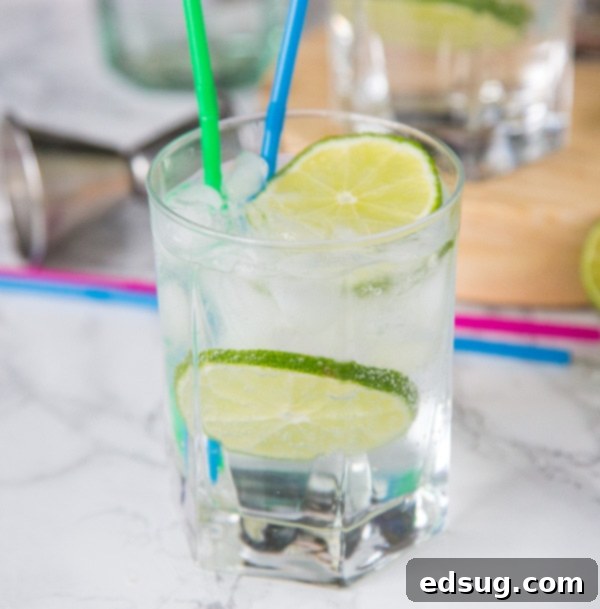The Ultimate Guide to Crafting the Perfect Gin and Tonic: A Timeless and Refreshing Cocktail
Discover the simple elegance of a Gin and Tonic – a beautifully balanced, cool, and invigorating cocktail made with your choice of gin, quality tonic water, and a twist of lime. Perfect for any occasion.
There’s a special joy in exploring new and intriguing cocktails when dining out, marveling at the creative combinations concocted by skilled mixologists. Yet, some drinks, like a classic Vodka Cranberry, remain steadfast favorites you can effortlessly recreate in the comfort of your own home. These timeless recipes offer a comforting familiarity and a guarantee of deliciousness.
I’ve always appreciated a well-made drink. My dad, for instance, has a strong preference for a Vodka Gimlet whenever he steps out. While I enjoy experimenting, the Gin and Tonic has recently captivated my palate, becoming one of my go-to choices. For a while, I was quite fond of a simple Vodka Soda, but a friend’s recommendation opened my eyes to the incredible versatility and nuanced flavors of gin. It was a revelation, and I haven’t looked back since!
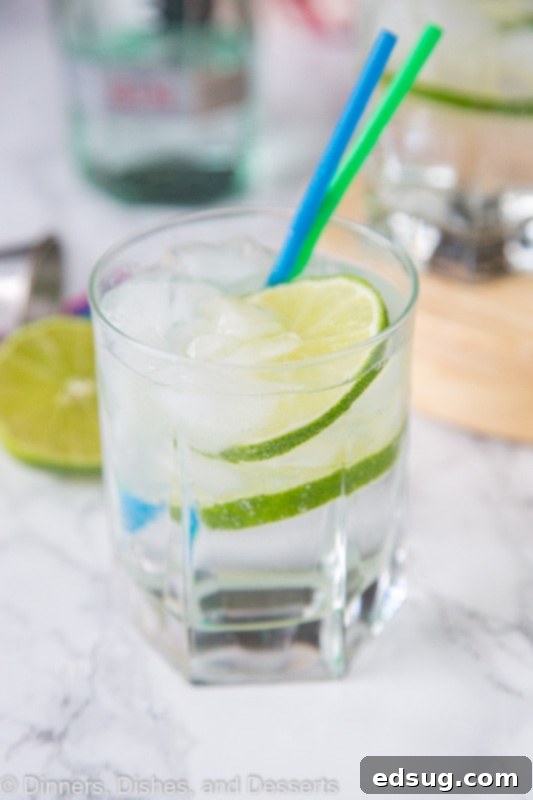
What Exactly is a Gin and Tonic?
At its heart, a Gin and Tonic (often affectionately shortened to G&T) is a deceptively simple cocktail, renowned for its refreshing qualities. It’s composed of just two primary ingredients: gin and tonic water. Traditionally, it’s garnished with fresh lime wedges, though lemon slices are also a popular and equally delightful alternative. The beauty of this drink lies in its simplicity, which also means that the quality of its components is paramount. This classic combination delivers a crisp, clean taste that makes it an ideal choice for a sunny afternoon or a sophisticated evening.
A Sip Through History: The Origin of the G&T
The Gin and Tonic isn’t just a popular cocktail; it boasts a rich history intertwined with colonial medicine and military life. Its origins trace back to the British East India Company and the British Army in India during the 18th and 19th centuries. Quinine, a key ingredient in tonic water, was used as an anti-malarial drug. However, its intensely bitter taste made it unpalatable. To make the quinine more agreeable, British officers began mixing it with gin, water, sugar, and lime – giving birth to the Gin and Tonic we know and love today. The gin helped mask the bitterness, while the lime added a vital source of Vitamin C, helping to combat scurvy. This practical concoction quickly became a staple, evolving from a medicinal necessity into a beloved recreational drink enjoyed worldwide. Its enduring popularity speaks to its perfect balance of flavor and refreshment.
The Art of Choosing Your Gin
The choice of gin is arguably the most critical decision when crafting a Gin and Tonic, as gin is the star of the show. Unlike cocktails where flavors might be masked by numerous mixers, the G&T allows the gin’s unique botanicals to truly shine. Therefore, it’s essential to select a gin whose flavor profile genuinely appeals to you. Gins vary widely, each offering a distinct character:
- London Dry Gin: This is the most common and traditional style, characterized by a dominant juniper flavor, often complemented by citrus (lemon, orange peel) and earthy notes (angelica root, coriander). Brands like Tanqueray and Bombay Sapphire are excellent examples, offering a crisp and robust base for a G&T.
- Plymouth Gin: Slightly less dry than London Dry, with a more earthy, aromatic, and subtly sweet profile, often featuring root botanicals. It offers a softer, more mellow G&T experience.
- Old Tom Gin: A slightly sweeter style of gin, bridging the gap between traditional London Dry and genever. Its sweetness can add an interesting dimension to a G&T, especially if you prefer a less bitter drink.
- Contemporary/New Western Gins: These gins push the boundaries of traditional botanical blends, often highlighting flavors other than juniper. Hendrick’s, for example, is famous for its distinct cucumber and rose notes, creating a uniquely refreshing G&T. Others might feature more floral, spicy, or herbaceous elements.
Don’t be afraid to experiment! The first time I tried a Gin and Tonic was in college, probably around the same time I first tasted a Long Island Iced Tea. Back then, it was always with cheap gin, and honestly, I wasn’t a fan. The quality made a huge difference! Today, with a discerning palate, I appreciate the nuances that a good quality gin brings, transforming a simple drink into an incredibly refreshing and complex experience.
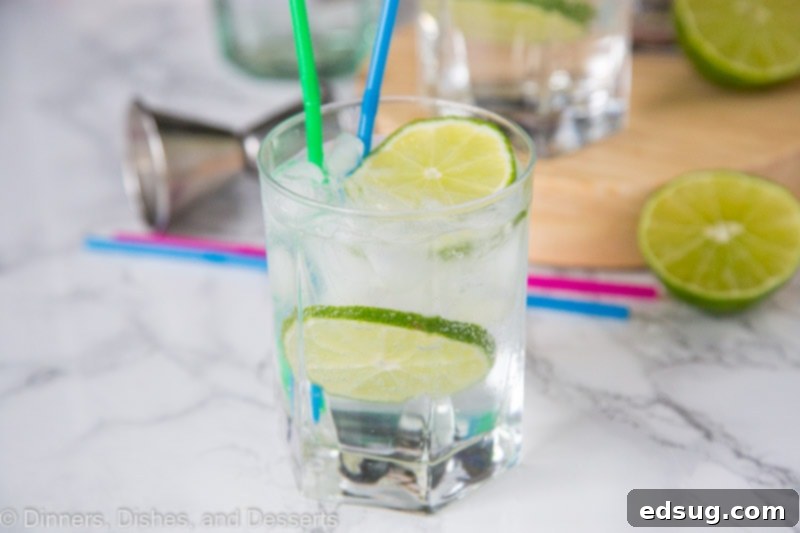
The Crucial Role of Tonic Water
While gin takes center stage, tonic water is far from a mere supporting act; it plays an equally crucial role in defining the character of your Gin and Tonic. Tonic water provides the bitterness from quinine, the effervescence, and a touch of sweetness. The quality and type of tonic water can dramatically alter the final taste profile of your cocktail.
- Classic Tonic Waters: These often have a prominent bitterness and a noticeable sweetness. Brands like Schweppes and Canada Dry are widely available and provide a familiar G&T experience.
- Premium Tonic Waters: The rise of artisanal gins has led to a boom in premium tonic waters. Brands like Fever-Tree, Q Mixers, and East Imperial offer a range of tonic waters with varying levels of sweetness, bitterness, and additional botanicals (like elderflower, Mediterranean herbs, or citrus). These premium options are often less sweet and allow the subtleties of the gin to come through more clearly.
- Diet Tonic: For those looking to reduce sugar intake, diet tonic waters are available. Be mindful that artificial sweeteners can sometimes impart an aftertaste, so choosing a good quality diet tonic is key.
Experimenting with different tonic waters is highly recommended. A gin that pairs beautifully with a classic tonic might also discover new dimensions when mixed with a lighter, more floral, or spicier premium tonic. The goal is to find a balance that enhances, rather than overwhelms, your chosen gin.
Finding Your Perfect Gin to Tonic Ratio
The ideal ratio of gin to tonic water is a matter of personal preference and often the subject of friendly debate among enthusiasts. Some prefer a stronger, gin-forward drink, while others lean towards a milder, more refreshing mix. Common ratios include:
- 1 part gin to 2 parts tonic water: This is my preferred ratio, offering a good balance where the gin’s botanicals are prominent but beautifully softened by the tonic. (e.g., 2 oz gin to 4 oz tonic)
- 1 part gin to 3 parts tonic water: A lighter, more diluted option, perfect for hot weather or when you want a longer, less alcoholic drink.
- Equal parts (1:1): For those who truly love the taste of gin and a bolder, more intense flavor.
Don’t be afraid to adjust these ratios to suit your taste. Start with a common ratio and then incrementally add more gin or tonic until you hit your sweet spot. Remember, the tonic water is sweet due to its sugar content, so there’s no need to add simple syrup or other sweeteners. The beauty of a G&T is its clean and simple elegance.
The Garnish Game: Beyond the Lime Wedge
While the traditional lime wedge is an iconic and perfect garnish for a Gin and Tonic, don’t limit yourself! The right garnish can elevate your drink, complementing and enhancing the botanicals in your gin. Here are a few ideas:
- Classic Lime: A squeeze of fresh lime juice brightens the drink and adds a tangy zest that cuts through the bitterness of the tonic.
- Lemon Slice or Peel: Offers a slightly different citrus note, often pairing well with more herbaceous or floral gins. A long lemon peel, expressed over the drink, releases aromatic oils for a sensory boost.
- Cucumber Ribbons: Especially fantastic with gins like Hendrick’s, cucumber adds a cooling, refreshing aroma and visual appeal.
- Grapefruit Slice: For a bitter and aromatic twist, grapefruit can be a sophisticated choice, especially with gins that have a citrusy or spicy profile.
- Herbs: A sprig of fresh rosemary, thyme, or basil can introduce wonderful aromatic complexities. Gently clap the herb between your hands before adding it to release its oils.
- Juniper Berries: A few extra juniper berries can amplify the gin’s core botanical flavor.
Consider the gin you’re using and pick a garnish that will harmonize with its unique characteristics. It’s a small detail that makes a big difference!
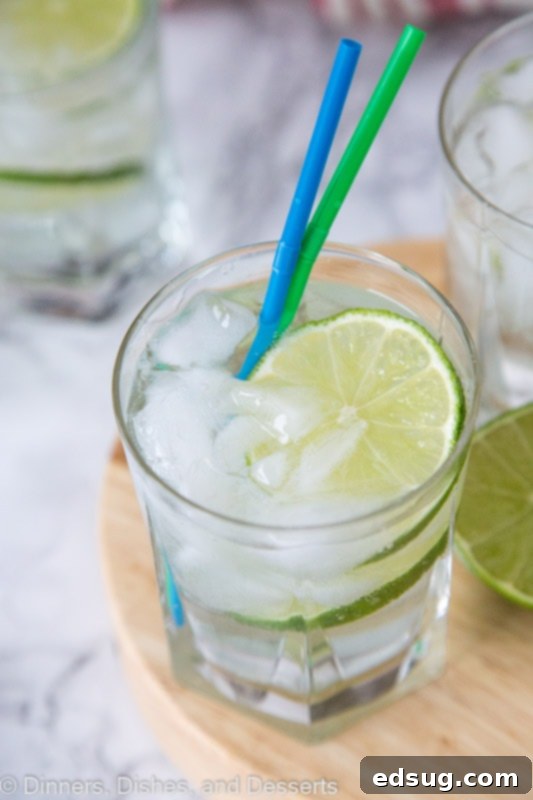
How to Make the Perfect Gin and Tonic
Crafting a superb Gin and Tonic is incredibly straightforward, requiring just two main ingredients and a few simple steps. The key is to ensure both your gin and tonic water are of good quality and, crucially, that you use plenty of ice. A G&T should always be served ice-cold for maximum refreshment.
Step-by-Step Instructions:
- Chill Your Glass: While not strictly necessary, chilling your glass beforehand (either in the freezer or by filling it with ice and letting it sit for a minute) helps keep your drink colder for longer and prevents rapid dilution. A highball glass is traditional, but a copa glass (balloon glass) can enhance the aromatics.
- Fill with Ice: Generously fill your chosen glass with fresh, good-quality ice cubes. The more ice you use, the slower it melts, keeping your drink perfectly chilled and undiluted.
- Add the Gin: Pour 2 ounces of your preferred gin into the glass.
- Add the Tonic Water: Gently top the gin with 4 ounces of cold tonic water. Pouring slowly down the side of the glass helps preserve the effervescence.
- Garnish and Serve: Finish with a fresh squeeze of a lime wedge, then drop the wedge into the drink. If using other garnishes, add them now. Stir gently once or twice to combine.
That’s it! It couldn’t be simpler. This elegant cocktail is perfect for any time you desire a crisp, clean, and utterly refreshing beverage. While I’m often a wine drinker at home (a Red Wine Spritzer is another favorite), a Gin and Tonic offers a wonderful change of pace. It’s the ideal single-serving cocktail to whip up on a Friday night, providing a perfect, simple end to the week.
I created a fun group on Facebook, and I would love for you to join us! It’s a place where you can share YOUR favorite recipes, ask questions, and see what’s new at Dinners, and Desserts (so that you never miss a new recipe)! If you’d like to check it out, you can request to join HERE.
Be sure to follow me on Instagram and tag #dinnersdishes so I can see all the wonderful DINNERS, DISHES, AND DESSERTS recipes YOU make!
Connect with Dinners, Dishes, and Desserts!
Be sure to follow me on my social media, so you never miss a post!
Facebook | Twitter | Pinterest | Instagram

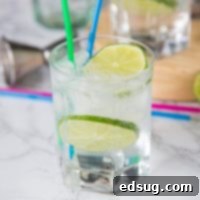
Gin and Tonic
Pin Recipe
Rate Recipe
Print Recipe
Ingredients
- 2 oz good quality gin
- 4 oz cold tonic water
- lime wedges (or other preferred garnish)
- plenty of ice
Instructions
-
Fill a highball or copa glass generously with ice.
-
Pour in the gin, then gently top with tonic water.
-
Garnish with a fresh lime wedge (or your chosen garnish) and serve immediately.
Nutrition
Nutrition information is automatically calculated, so should only be used as an approximation.
Additional Info
Like this recipe? Leave a comment below!
